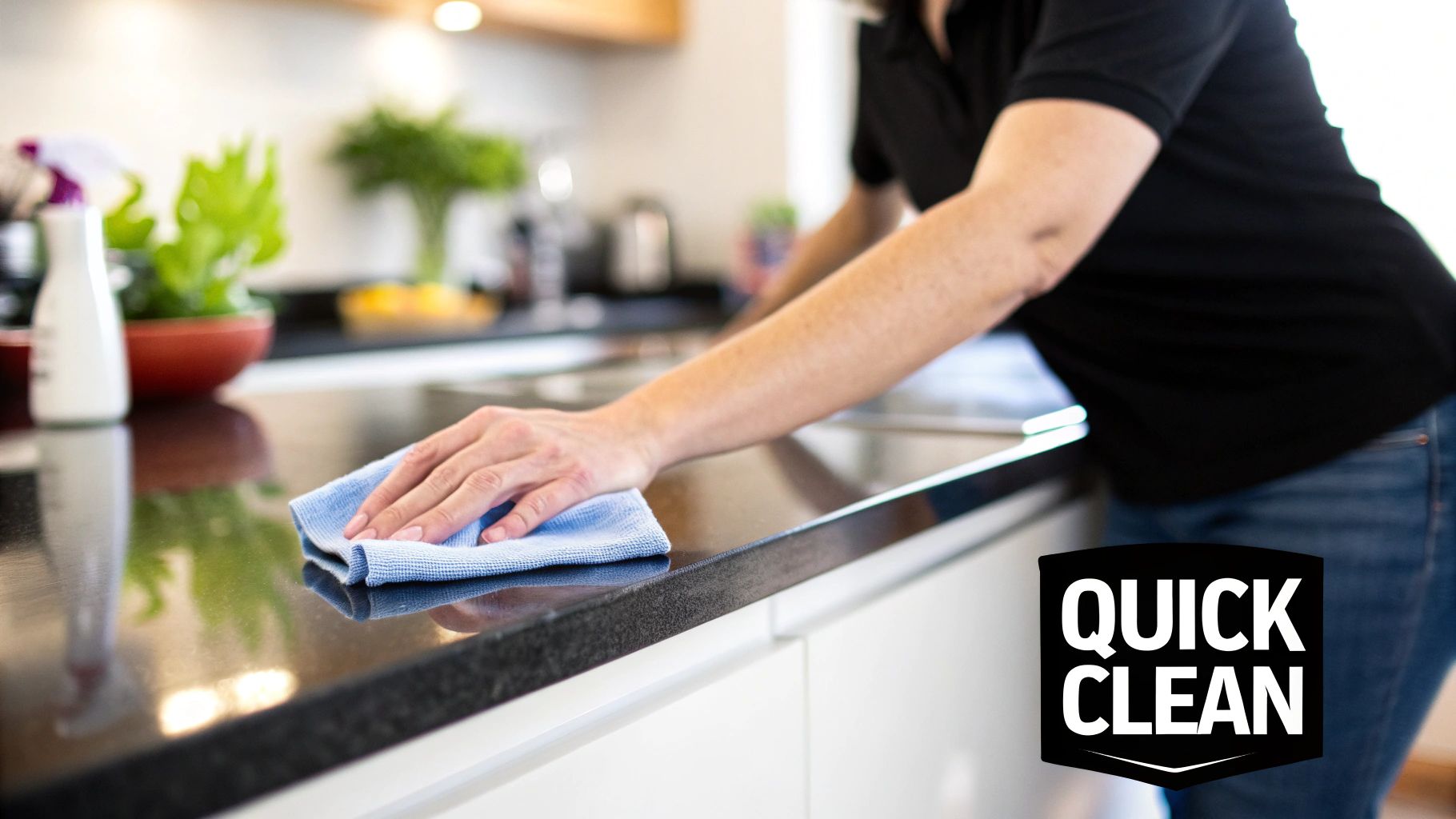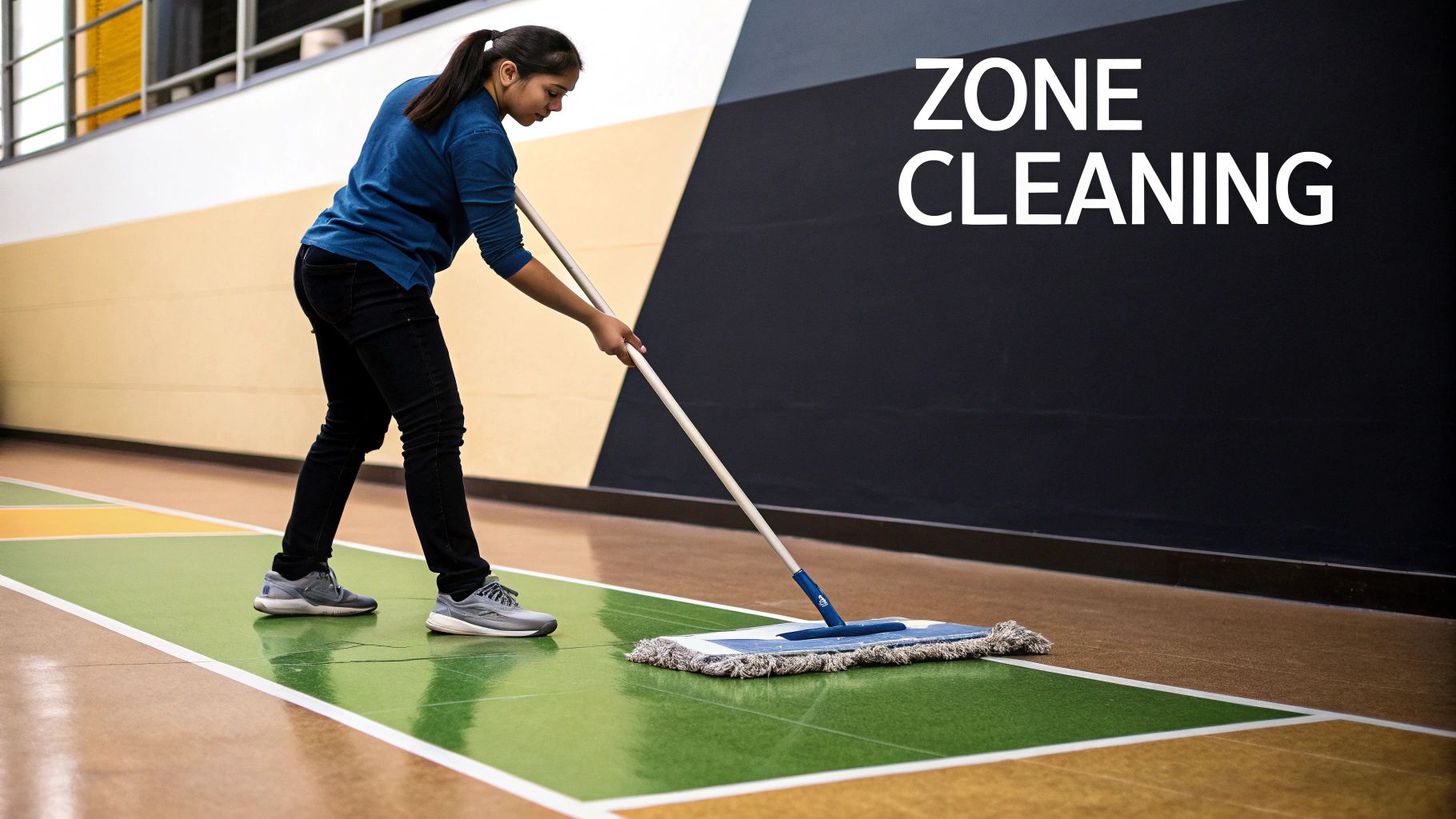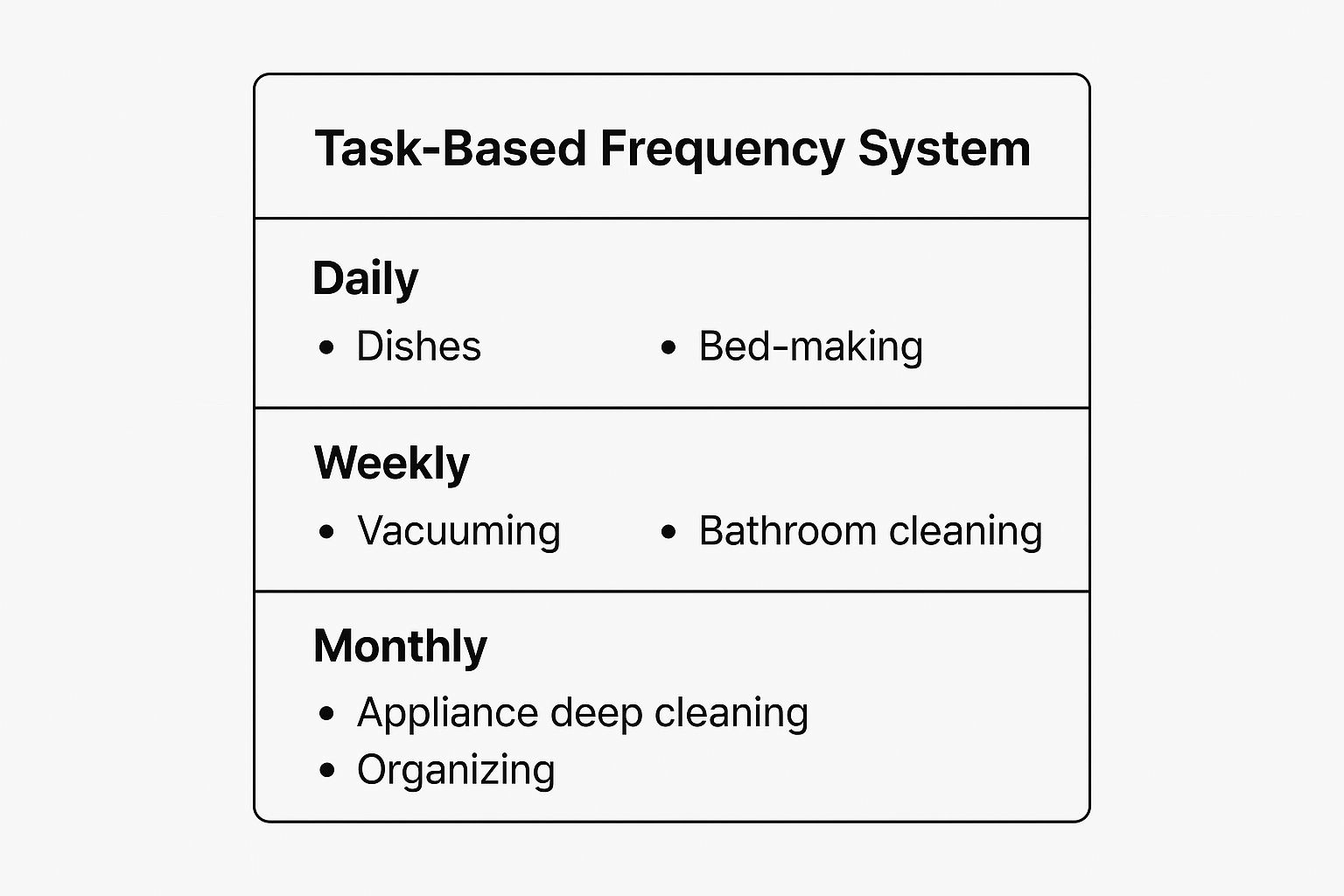The age-old question, 'How often should I clean my house?' doesn't have a single, one-size-fits-all answer. The truth is, the ideal cleaning frequency depends entirely on your lifestyle, home size, household members (including furry ones!), and personal standards. A bustling family home in Michigan with pets and kids will require a different approach than a minimalist apartment for a single professional.
Feeling overwhelmed by endless chores or guilty about letting things slide is a common frustration, but it doesn't have to be your reality. The secret isn't about cleaning harder; it's about cleaning smarter and finding a sustainable system. This guide moves beyond generic advice to present seven distinct, expert-backed cleaning systems designed to bring order to the chaos.
We'll break down everything from quick daily tidies that prevent mess from ever taking hold to structured weekly plans and strategic seasonal deep cleans. By exploring these methods, you will discover a rhythm that fits seamlessly into your life. Our goal is to help you transform cleaning from a dreaded task into a manageable, and even satisfying, routine. Let's find the perfect schedule that leaves your home consistently clean and gives you back your valuable time.
1. Daily Quick Clean Routine
The most effective answer to "how often should I clean my house?" isn't a single marathon session but a series of small, consistent actions. The Daily Quick Clean Routine is a foundational approach that transforms housekeeping from a monumental chore into a manageable daily habit. It involves dedicating just 15 to 30 minutes each day to high-impact tasks, preventing the buildup of dirt and clutter that can make a home feel overwhelming.

This method, popularized by systems like the FlyLady method and championed by professional organizers, is about maintenance over deep cleaning. By integrating these tasks into your daily schedule, you maintain a baseline of cleanliness, significantly reducing the effort required for weekly or monthly deep cleans.
How to Implement a Daily Routine
Creating a sustainable daily routine is about starting small and being consistent. The goal is progress, not perfection.
- Make the Bed: This single, two-minute task instantly makes a room look more organized and sets a productive tone for the day.
- Kitchen Counter Wipe-Down: After every meal preparation, take a minute to wipe down countertops and the stovetop. This prevents food residue from hardening and becoming a bigger chore.
- Manage the Dishwasher: Make it a rule to run the dishwasher every night and unload it every morning. This prevents dirty dishes from piling up in the sink, a major source of kitchen clutter.
- Quick Bathroom Tidy: Keep a microfiber cloth or cleaning wipes under the sink. After your morning routine, quickly wipe the counter, faucet, and sink basin. This takes less than 60 seconds.
- The 15-Minute Evening Tidy: Before winding down for the night, set a timer for 15 minutes. Use this time to put things back where they belong: fold throws, fluff pillows, stack mail, and clear any stray items from the floor. Involving the entire family can turn this into a quick, five-minute team effort.
Key Insight: The power of a daily routine isn't in scrubbing your house from top to bottom. It's in the cumulative effect of small, consistent actions that prevent chaos from taking hold.
2. Weekly Deep Clean Schedule
While a daily routine keeps surface-level clutter at bay, the Weekly Deep Clean Schedule is where you tackle the more intensive tasks that maintain the true hygiene and appearance of your home. This approach dedicates a specific block of time once a week to perform a more thorough, systematic cleaning. It’s the answer to "how often should I clean my house?" for foundational tasks like vacuuming, mopping, and disinfecting bathrooms.

This method, a cornerstone of traditional homemaking and professional cleaning services, bridges the gap between daily tidying and less frequent seasonal cleans. By consistently addressing dust, grime, and germs on a weekly basis, you prevent buildup that requires significantly more effort to remove later. It establishes a rhythm that keeps your living space consistently fresh and healthy.
How to Implement a Weekly Routine
A successful weekly clean depends on having a clear plan and efficient strategy. The goal is to be thorough without spending the entire day cleaning.
- Create a Checklist: Design a room-by-room checklist of essential tasks. This includes dusting all surfaces, vacuuming carpets and rugs, mopping hard floors, changing bed linens, and thoroughly cleaning the kitchen and bathrooms (toilets, showers, sinks, and mirrors).
- Work Top to Bottom: Always start with the highest surfaces in a room, like dusting ceiling fans or tall furniture, and work your way down. This ensures that any dislodged dust and debris land on the floor to be vacuumed or mopped up last.
- Gather Supplies First: Before you start, collect all your cleaning supplies: all-purpose cleaner, glass cleaner, microfiber cloths, vacuum, mop, and bucket. This prevents you from wasting time searching for tools mid-task.
- Designate a Cleaning Day: Many people choose a "Sunday Reset" or a Saturday morning to complete their weekly tasks. Making it a family event, where each person is assigned specific responsibilities, can speed up the process and teach valuable life skills.
- Focus and Energize: Turn on some energizing music or a podcast. Focusing on one task at a time (e.g., dusting every room, then vacuuming every room) can be more efficient than completing one room entirely before moving to the next.
Key Insight: A weekly deep clean isn't about achieving perfection. It's about a consistent, dedicated effort that resets the cleanliness of your home, making the entire week more pleasant and manageable.
3. Zone Cleaning Method
For those who find the idea of tackling the entire house at once daunting, the Zone Cleaning Method offers a structured, less overwhelming alternative. This strategic approach divides your home into manageable "zones," dedicating focused cleaning time to one specific area each week or month. Instead of superficially cleaning every room, you give one zone a thorough deep clean, ensuring every part of your home gets detailed attention on a rotating basis.

This system, made popular by home management experts like FlyLady and Clean Mama, works alongside a daily tidy-up routine. It answers the question of "how often should I clean my house?" by breaking deep cleaning into focused, cyclical tasks. This prevents burnout and ensures that tasks like dusting baseboards or wiping down cabinet fronts are never forgotten.
How to Implement a Zone Cleaning System
The key to zone cleaning is a logical division of your home and a consistent schedule. You can tailor it completely to your home's unique layout and your available time.
- Define Your Zones: Start by dividing your home into five logical areas. A common setup might be: Zone 1: Entryway and Dining Room; Zone 2: Kitchen; Zone 3: Main Bathroom and one other room (like a child's bedroom or office); Zone 4: Master Bedroom and Bathroom; Zone 5: Living Room.
- Assign Time Blocks: Dedicate a specific day or a few sessions during the week to your active zone. This could be 30-60 minutes on a set day, or 15 minutes each day for four days. The goal is to complete the deep cleaning tasks for that zone within the week.
- Create Zone-Specific Checklists: For each zone, list the deep cleaning tasks that go beyond the daily tidy. For the kitchen zone, this might include wiping cabinet fronts, cleaning the microwave, and decluttering the pantry. For the bedroom zone, it could be washing bedding, dusting furniture, and vacuuming under the bed.
- Keep Supplies Handy: To make the process seamless, consider creating a small cleaning caddy or keeping essential supplies in or near each zone. This eliminates time wasted gathering materials.
- Post the Schedule: Make the zone schedule visible for the whole family. This helps manage expectations and encourages others to participate or at least keep the active zone tidier.
Key Insight: Zone cleaning transforms deep cleaning from a dreaded annual event into a manageable weekly habit. It ensures every corner of your home receives consistent, focused attention without requiring a full day of labor.
4. Seasonal Deep Cleaning
Beyond the weekly grind, a crucial part of knowing how often you should clean your house involves tackling larger, less frequent tasks. Seasonal Deep Cleaning is an intensive approach, performed two to four times a year, that addresses the deep-seated grime and maintenance jobs essential for a home's long-term health and cleanliness. This method aligns with the changing seasons, using environmental shifts as a cue to perform specific, high-impact cleaning.
This tradition, reminiscent of "spring cleaning" and championed by home maintenance experts like Bob Vila, is less about tidiness and more about preservation. By systematically addressing these tasks, you protect your investment, improve indoor air quality, and prevent minor issues from becoming major, costly repairs. It’s the yearly physical for your home.
How to Implement Seasonal Deep Cleaning
A successful seasonal clean requires planning and a clear focus. The goal is to work through a comprehensive checklist methodically, rather than getting overwhelmed by the scale of the tasks.
- Spring Refresh: As you open the windows to let in fresh air, focus on removing winter's buildup. This is the time for deep carpet cleaning, washing all windows inside and out, cleaning window screens, and scheduling HVAC maintenance.
- Summer Maintenance: Prepare your outdoor and high-traffic areas for heavy use. This includes power washing the deck or patio, organizing the garage, and cleaning the grill. Inside, focus on cleaning ceiling fan blades and washing all bedding, including duvet inserts and mattress pads.
- Fall Preparation: As the weather cools, prepare your home for winter. Key tasks include cleaning out gutters to prevent ice dams, having your furnace and chimney inspected, and washing exterior siding. It’s also a great time to declutter before the holidays.
- Winter Interior Focus: With more time spent indoors, turn your attention to deep indoor tasks. This is ideal for organizing closets and pantries, washing curtains and blinds, and deep cleaning appliances like the oven and refrigerator.
Key Insight: Seasonal cleaning isn't just about making your house sparkle. It’s a proactive home maintenance strategy that preserves your property's value and ensures a healthy living environment year-round. Using a detailed checklist can make these large projects manageable. For an in-depth guide, you can explore essential deep cleaning checklists for professional results on custom-maids.co.
5. Task-Based Frequency System
While daily, weekly, and monthly schedules provide a helpful framework, the most efficient answer to "how often should I clean my house?" often lies in a more intuitive approach. The Task-Based Frequency System organizes cleaning around the natural lifecycle of a task itself, rather than a rigid calendar. This method, favored by professional cleaning services and efficiency experts, creates a logical routine where tasks are done precisely when needed, preventing both neglect and unnecessary work.
This approach acknowledges that not all cleaning needs are created equal. Wiping down kitchen counters is a daily necessity, while deep cleaning your oven is a less frequent requirement. By categorizing tasks based on their required frequency, you build a highly customized and effective cleaning rhythm that adapts to your specific household.
How to Implement a Task-Based System
Adopting this system involves observing your home's needs and creating categories for your chores. The goal is to align your effort with the actual rate at which dirt and clutter accumulate.
- Categorize Your Tasks: Start by listing all your household chores and group them by ideal frequency. Create lists for daily, weekly, bi-weekly, monthly, and seasonal tasks.
- Start Small and Build: Don't try to implement the entire system at once. Begin with the daily tasks (making the bed, dishes) and weekly tasks (vacuuming, laundry). Once these become habit, integrate the monthly and seasonal items.
- Group Similar Frequencies: Schedule your tasks to maximize efficiency. For example, dedicate a specific day to completing all your weekly tasks, like vacuuming, dusting, and changing bed linens, in one go.
- Use Tracking Tools: A simple chart on the fridge, a dedicated notebook, or a cleaning app can be invaluable. These tools help you keep track of what needs to be done and when, ensuring nothing falls through the cracks.
- Adjust for Your Lifestyle: A home with pets and children will have different frequency needs than a single-person apartment. Be prepared to adjust your schedule based on your household's size, habits, and the current season.
This visualization provides a quick reference for how to categorize common chores within a Task-Based Frequency System.

As the summary illustrates, the system works by creating distinct tiers of cleaning, from daily maintenance to less frequent deep cleans, which you can learn more about when you create a cleaning schedule on custom-maids.co.
Key Insight: The Task-Based Frequency System shifts the focus from "When did I last clean this?" to "When does this actually need cleaning?" It's a strategic, needs-based approach that makes your efforts more impactful.
6. Speed Cleaning Method
For those who find the thought of dedicating hours to cleaning daunting, the Speed Cleaning Method offers a strategic solution. It’s an approach that answers the question "how often should I clean my house?" with "as efficiently as possible." This technique is about maximizing impact in a minimal amount of time by using systematic patterns, the right tools, and a focused mindset. It transforms cleaning from an endless project into a series of targeted, high-intensity sprints.
This method, detailed by experts like Jeff Campbell and utilized by professional cleaning services, is not about cutting corners but about eliminating wasted time and motion. It prioritizes efficiency to achieve a high standard of cleanliness quickly, making it perfect for busy homeowners, last-minute guest preparations, or regular maintenance without the marathon commitment.
How to Implement Speed Cleaning
Adopting a speed cleaning mindset requires a shift in approach, focusing on workflow and preparation to make the most of every minute.
- Prepare a Cleaning Caddy: The cornerstone of speed cleaning is having all your supplies in one portable caddy. Stock it with microfiber cloths, an all-purpose cleaner, glass cleaner, and a duster. This eliminates time spent walking back and forth to retrieve supplies.
- Work Top-to-Bottom, Left-to-Right: Always start at the highest point in a room (e.g., dusting ceiling fans or high shelves) and work your way down. Gravity will pull dust and debris downward, so you only have to vacuum or mop once. Moving in a consistent direction around the room, like left to right, ensures you don't miss spots or clean the same area twice.
- Set a Timer: Challenge yourself by setting a timer for each room or task, such as a 10-minute kitchen blitz or a 20-minute bathroom deep clean. This creates a sense of urgency and helps you stay focused on the task at hand, preventing distractions.
- Focus on High-Impact Areas: When time is short, concentrate on what makes the biggest visual difference. This includes shining faucets, cleaning mirrors, wiping down kitchen counters, and fluffing couch pillows. These small tasks have a disproportionately large effect on the overall perception of cleanliness. If you are interested in refining your technique, you can explore more about the Speed Cleaning Method on custom-maids.co.
Key Insight: Speed cleaning isn’t about being sloppy; it’s about being smart. By systemizing your process and focusing your energy, you can maintain a consistently clean home in a fraction of the time.
7. Maintenance vs. Deep Clean Split
One of the most sustainable answers to "how often should I clean my house?" is to stop viewing cleaning as a single activity. The Maintenance vs. Deep Clean Split is a professional-grade system that separates everyday upkeep from less frequent, intensive tasks. This dual approach prevents the overwhelm of trying to do everything at once, ensuring your home stays consistently tidy while still getting the thorough sanitation it needs.
This method, a standard in the professional cleaning industry and popularized by home management experts like Clean Mama, treats your home like any other system needing both routine checks and periodic overhauls. Maintenance tasks prevent daily chaos, while scheduled deep cleans tackle grime and neglect in areas that don't need constant attention.
How to Implement a Maintenance vs. Deep Clean Split
Success with this system relies on clear scheduling and realistic expectations. The goal is to create a rhythm where daily tidiness is a given, and deep cleaning is a scheduled, manageable project rather than an emergency response to a messy house.
- Daily Maintenance: These are the non-negotiable tasks that keep the home functional and prevent buildup. This includes making beds, wiping kitchen surfaces after use, managing dishes, and a quick 15-minute evening tidy to reset the main living areas.
- Weekly Deep Clean Tasks: These are more involved chores assigned to specific days. Examples include thoroughly scrubbing bathrooms (toilets, showers, sinks), mopping floors, vacuuming all carpets, and dusting furniture.
- Monthly Deep Clean Tasks: Focus on areas that can go longer without attention. This could involve cleaning inside appliances like the microwave and oven, wiping down baseboards and light fixtures, or vacuuming upholstery.
- Quarterly & Annual Deep Cleans: Reserve the biggest jobs for these. Think deep cleaning carpets, washing all windows inside and out, decluttering closets and garages, or pressure washing exterior surfaces. These are also great opportunities to consider professional help for specialized tasks.
Key Insight: Separating maintenance from deep cleaning transforms your mindset. Instead of constantly feeling behind, you can feel accomplished with daily maintenance while knowing the bigger tasks have a dedicated, future time slot.
7 Methods for House Cleaning Frequency Comparison
| Cleaning Method | Implementation Complexity 🔄 | Resource Requirements ⚡ | Expected Outcomes 📊 | Ideal Use Cases 💡 | Key Advantages ⭐ |
|---|---|---|---|---|---|
| Daily Quick Clean Routine | Low - requires daily discipline but simple | Low - 15-30 min daily, basic supplies | Consistently clean environment, stress reduction | Everyday maintenance, preventing buildup | Prevents overwhelm, forms positive habits |
| Weekly Deep Clean Schedule | Medium - 2-4 hour focused weekly session | Medium - extended time, thorough supplies | Thorough hygiene, addresses deep cleaning needs | Weekly comprehensive cleaning | Covers missed areas, predictable scheduling |
| Zone Cleaning Method | Medium - initial planning, zone mapping | Medium - 30-60 min per zone, distributed | Balanced workload, all areas regularly cleaned | Flexible weekly/monthly zone-focused cleaning | Prevents overwhelm, reduces decision fatigue |
| Seasonal Deep Cleaning | High - quarterly, intensive planning | High - time-consuming, may need professionals | Deep sanitization, seasonal maintenance | Long-term upkeep, seasonal home prep | Addresses neglected areas, extends home life |
| Task-Based Frequency System | High - requires tracking multiple schedules | Variable - depends on tasks frequency | Optimized cleaning efficiency, prevents overwork | Adaptable to lifestyle and task needs | Efficient, logical, prevents unnecessary cleaning |
| Speed Cleaning Method | Medium - requires technique and focus | Low - 15-45 min focused sessions | Quick impact cleaning, maintains tidiness | Busy schedules needing fast cleaning | High productivity, reduces procrastination |
| Maintenance vs. Deep Clean Split | Medium - dual schedules to manage | Medium - daily upkeep + periodic deep clean | Consistent baseline cleanliness + deep restoration | Managing daily upkeep plus thorough cleanings | Flexible, efficient resource use |
Customizing Your Clean: Create a Home That Shines
Navigating the question of "how often should I clean my house" can feel overwhelming, but as we've explored, there is no single right answer. The true key to a consistently clean home lies not in a rigid, one-size-fits-all schedule, but in building a personalized system that aligns with your lifestyle, your home's specific needs, and your personal tolerance for mess. The methods detailed in this guide, from a Daily Quick Clean to a Seasonal Deep Clean, are not mutually exclusive rules; they are tools in your cleaning toolkit.
The most effective and sustainable cleaning strategy often involves a hybrid approach. You might find that combining a Daily Quick Clean Routine for high-traffic areas with a Weekly Zone Cleaning Method prevents chores from piling up. This synergy ensures that daily upkeep is manageable while deeper cleaning is addressed systematically, preventing weekend-long cleaning marathons.
From Theory to Action: Your Next Steps
The ultimate goal is to transform cleaning from a reactive chore into a proactive habit. To do this, you must move from simply reading about these methods to actively implementing them. Start by evaluating your current situation honestly.
- Identify Your Biggest Pain Points: Is it the never-ending pile of dishes, the dust bunnies under the furniture, or the soap scum in the shower? Pinpointing your main frustrations will help you prioritize which system to try first. A Task-Based Frequency System can directly address these recurring issues.
- Start Small and Build Momentum: Don't try to implement a full seasonal deep clean and a new daily routine all at once. Choose one method, like the Speed Cleaning Method, and try it for a week. Success builds confidence and makes it easier to layer on additional habits over time.
- Schedule It Like an Appointment: Whether you choose a daily, weekly, or monthly system, put your cleaning blocks on your calendar. Treating this time with the same importance as any other appointment makes you far more likely to stick with it.
Key Takeaway: The perfect cleaning schedule is the one you can consistently follow. It's about progress, not perfection. If a system feels too demanding, it's not a personal failure; it's a sign that the system needs adjusting to better fit your life.
Ultimately, mastering your cleaning routine is about more than just having a tidy space. It's about creating a peaceful, healthy environment for yourself and your family. It's about reducing stress, reclaiming your weekends, and fostering a sense of pride and comfort in your own home. Whether you're a homeowner in Michigan juggling family life or a renter wanting to maintain your space, finding your rhythm is invaluable. If that rhythm feels out of reach, remember that professional help is a powerful tool for resetting your environment and your mindset.
Feeling overwhelmed or simply ready to reclaim your free time? The experts at Custom Maids have spent over 40 years helping Michigan residents answer the question of "how often should I clean my house" with a simple solution: let us handle it. We create completely customized cleaning plans that fit your schedule and needs, so you can enjoy a flawlessly clean home without the stress. Contact Custom Maids for a free, no-obligation estimate today!

